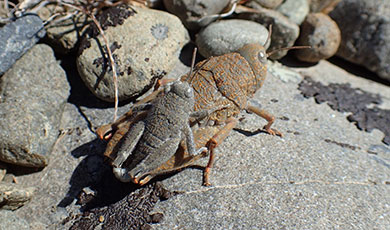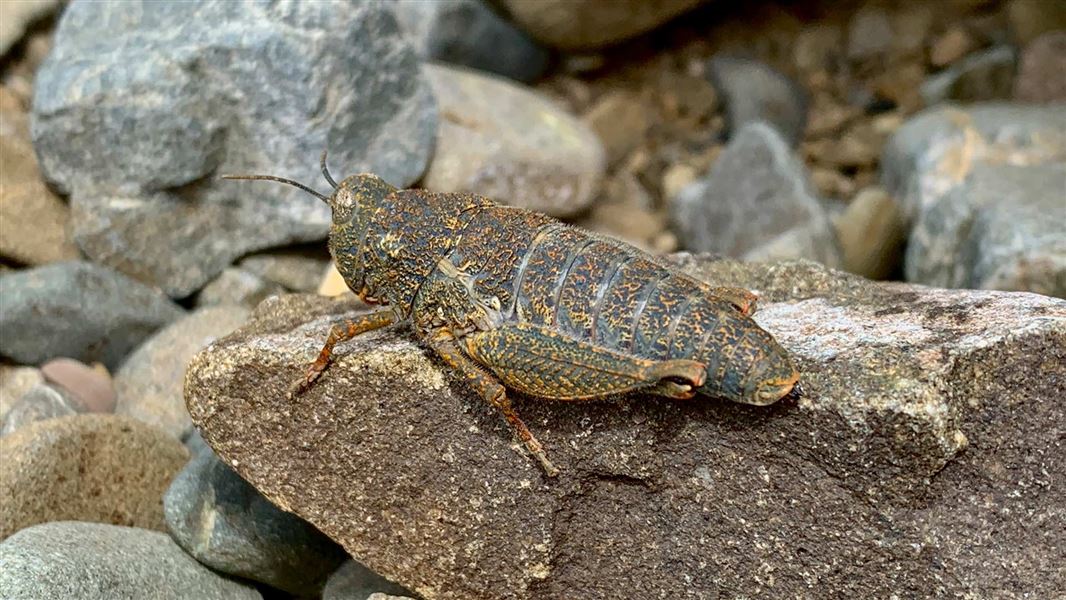Population: 250-1000 mature adults
New Zealand status: Endemic
Conservation status: Nationally Endangered
Threats: Predation, habitat loss, warming climate
The Brachaspis robustus is at serious risk from habitat loss, a warming climate and predators. The National Predator Control Programme protects the robust grasshopper and other native species from predators.
The robust grasshopper is only found along the edges of the braided river of the Mackenzie Basin. This is a very specialised habitat of stones and boulders.
It comes in many shades of grey and rusty brown matching the stones and silty soils in its habitat.
Facts

Robustus pair showing two colours
Image: Tara Murray, DOC
It looks a lot like its closest relative, the Brachaspis nivalis who live in higher mountain areas, are much more abundant and are regularly seen by trampers.
It is New Zealand's largest lowland grasshopper. Females are about double the size of a male. The size difference is obvious when breeding.
It is a 'basker'. It needs lots of sun to get warm enough to feed and mature eggs. Eggs need a cold winter period, possibly below, to fully develop.
The species is a generalist herbivore that can eat both native plants and exotic weeds that are invading their habitat.
Weeds that cover or shade the ground reduce habitat availability. It also can't jump in grass or tall vegetation to escape from predators.
Both males and females can jump well when in open habitats but are terrible at landing. It often lands on its back.
Robust grasshopper slow motion jump
Our work
Early observations
A lot of the early knowledge about the robust grasshopper came from observations made by DOC's Project River Recovery (PRR) team. The PRR team were seeing the grasshoppers while on the braided rivers doing bird surveys.
The team actively started recording these observations in the 1990s to understand grasshopper distribution.
Current work
The PRR team now run specific grasshopper surveys every year to monitor numbers in particular sites. They also do distribution surveys to try and work out where on the braided rivers the grasshoppers are inhabiting.
Most of the information about the robust grasshopper has come from work undertaken by PhD and MSc students. This includes how to do the annual surveys and understanding the grasshopper’s ecology and behaviour. This work is supported by the PRR team and DOC science advisors to complete intensive studies.
The world's first insect exclusion fence
In 2018, with funding from Te Manahuna Aoraki, a predator exclusion fence was put up around a small area of grasshopper habitat. This is thought to be the world's first exclusion fence built specifically for the protection of insects. It has been established to learn more about the species and help them recover their numbers.
It is still early days, but it is hoped this enclosure will provide enough protection that more grasshoppers can be raised. And eventually population numbers will support releasing them into other areas where numbers are low.
Threats
The population is in decline due to habitat loss, warming climate and predation. They are particularly smelly which makes them an easy target for hedgehogs and stoats who hunt by smell.
You can help
Don't feed hedgehogs.
Get involved in a predator control programme in your local community.
Consider a career in entomology or ecology to become a future protector of NZ's threatened invertebrates.
